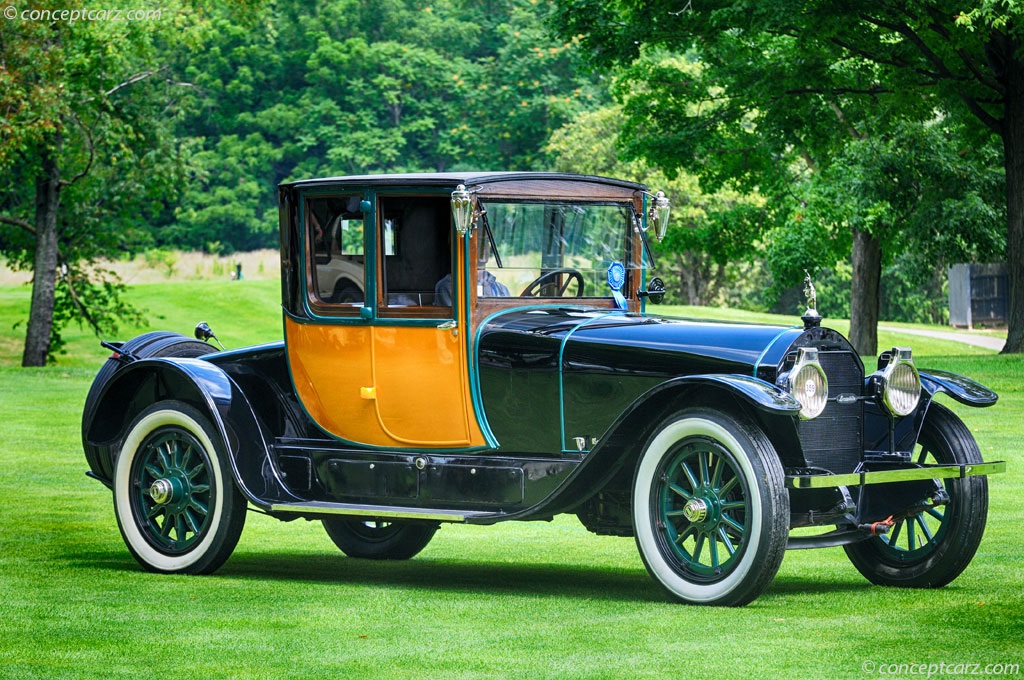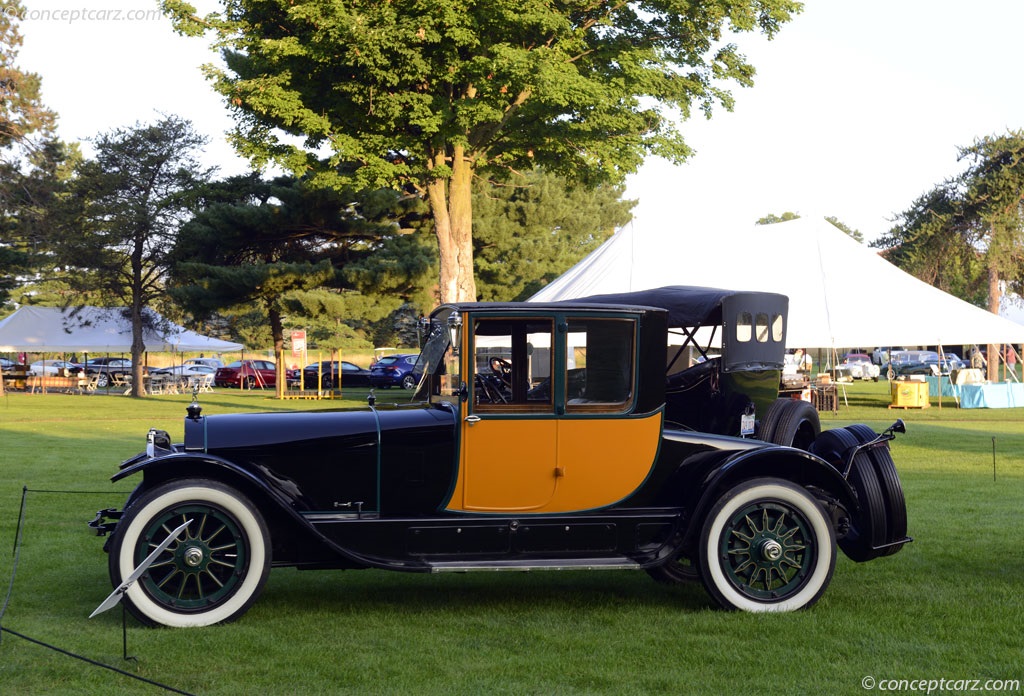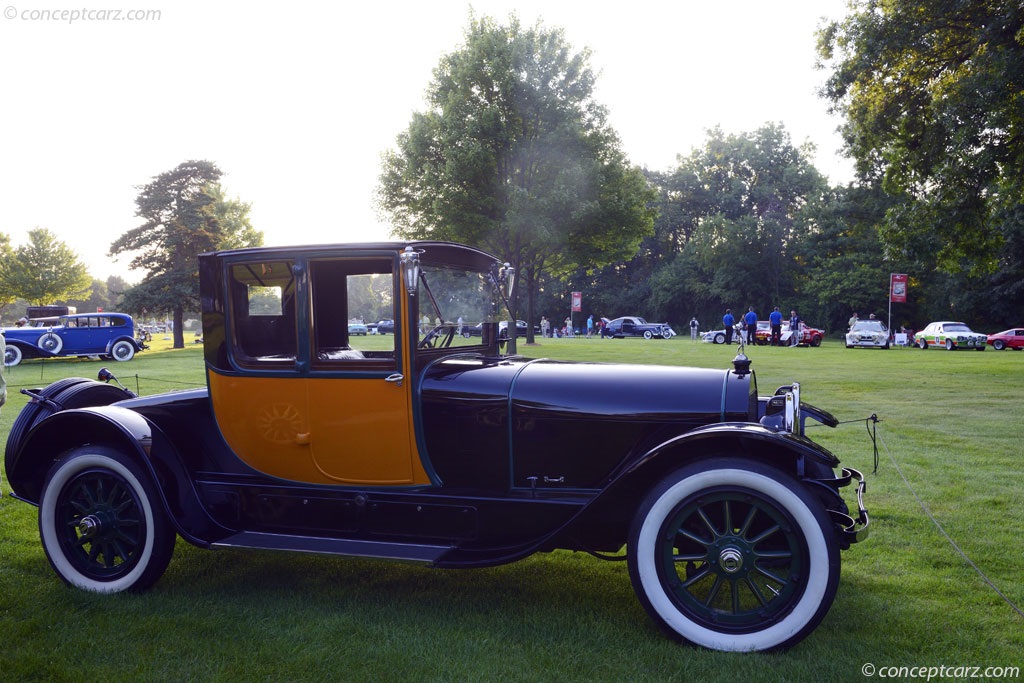Locomobile was organized in June 1899 by John Brisben Walker, Cosmopolitan magazine editor and publisher, and Amzi Lorenzo Barber, who earned a fortune in the asphalt business. Production began with small steam-powered cars built to a Stanley design. The early years were defined by management and ownership changes, a merger, and the development of a new gasoline model. 
3-Passenger Sedan by Locke
View info and historyQuality construction earned the company an enviable reputation, reinforced by a brief but glorious competition career with entries in the 1905 Gordon Bennett Cup in France and the 1905 and 1906 Vanderbilt Cup races held at Long Island, where a third-place podium was scored in 1905. The 1906 Vanderbilt Cup car, 'Old 16,' was driven to victory at the 1908 Vanderbilt Cup by George Robertson, setting a new speed record and becoming the first American-built car to win the prestigious event. After additional victories in 1908, Locomobile abandoned racing by 1909, and its road models were reorganized for 1909 and beyond. Many of the Locomobile vehicles built in the immediate years that followed were given ornate and luxurious decorations, with lamps and metalwork designed by Tiffany & Co., and Elsie De Wolf. The company's roster of clientele included many of the most influential, famous, and wealthy of the era.The six-cylinder Model 48 was introduced in 1911, followed by the new (and six-cylinder) Model 38 by 1912 and produced through 1918. By 1914, Locomobile had ceased production of four-cylinder models to focus on its range of sixes.Locomobile Model 48
Designed by Andrew Riker, the Model 48 would remain in production until the end of the marque's existence. The Locomobiles used the finest materials available, and no shortcuts were taken in its construction or finishes.
3-Passenger Sedan by Locke
View info and historyThe 142-inch wheelbase frame used chassis members that were pressed from chrome-nickel steel, then heat-treated and hot-riveted together for strength and rigidity. The suspension was via chrome-nickel-tungsten steel leaf springs, with 3/4 elliptical at the rear and semi-elliptical in the front.Its 6-cylinder engine had bore and stroke dimensions of 4½' x 5½, and the iron T-head cylinders were cast in pairs and bolted to a bronze crankcase. The crankcase contained a drop-forged alloy steel crankshaft that was both dynamically and statically balanced and rode in seven main bearings. There was a bronze-bodied carburetor, an aluminum intake, and the exhaust valves were chrome-cobalt steel. Coil and battery ignition ignite dual ignition through a pair of 6-cylinder distributors, and the gearbox casing was cast in manganese bronze.Locomobile Model 38
The Model 38 was built using the same high-quality components as its Model 48 sibling but used a slightly smaller 140-inch wheelbase chassis and powered from a 425 cubic-inch T-head inline 6-cylinder engine fitted with a Locomobile Single Updraft carburetor and producing 63 horsepower. While other manufacturers used 3-speed gearboxes for their high horsepower engines with massive torque, Locomobile stood by its 4-speed manual transmission. Two-wheel mechanical brakes at the rear provided the stopping power. The solid front axle was suspended by semi-elliptic leaf springs, while the full-floating rear axle used ¾-elliptic leaf springs.
3-Passenger Sedan by Locke
View info and historyMost designs came from Locomobile's own Custom Body Department under the direction of former Kellner designer J. Frank de Causse, and many were conservative sedans, limousines, or open touring bodies. They were admired for their simplicity and lack of compound bends, favoring simple curves and straight lines. With no body-building facility of its own, Locomobile chose the best coachbuilders to create the coachwork. With prices that ranged from $4,400 to $5,700, the Locomobile Model 38 was only attainable to those with well-endowed banking accounts. Locomobile was acquired by Durant Motors in July 1922, which continued to use the Locomobile nameplate for its prestigious line of automobiles until 1929. A few years earlier, in 1925, the 8-66 Junior Eight had been introduced, powered by a more contemporary straight-eight engine and priced at a more obtainable $1,7,85. An even smaller Junior Six model was introduced in 1926, but it remained in production for one model year. The Junior Six was joined by a larger Model 90 that would remain in production until 1929. Another eight-cylinder model, the 8-70, began production in 1927 using a readily available Lycoming engine. 
3-Passenger Sedan by Locke
View info and historyThe models introduced near the company's demise were affordable; they were intended to boost production and improve the company's finances. Instead, they tarnished the company's reputation and damaged its market position. Like many other manufacturers, the company stumbled in the early Twenties, affected by both the post-WWI recession and the flood of military trucks that came on the market after the war and hindered sales of its Riker truck line. Acquired by Hare's Motors when Billy Durant's empire collapsed, it became a victim of inspired mismanagement and manipulation, entering receivership in 1929. Had the company survived into the 1930s, it surely would have fallen victim to the Great Depression, a fate that claimed many of the prestigious automakers that relied on the limited pool of wealthy buyers.
by Daniel Vaughan | Dec 2023

3-Passenger Sedan by Locke
View info and history
Designed by Andrew Riker, the Model 48 would remain in production until the end of the marque's existence. The Locomobiles used the finest materials available, and no shortcuts were taken in its construction or finishes.

3-Passenger Sedan by Locke
View info and history
The Model 38 was built using the same high-quality components as its Model 48 sibling but used a slightly smaller 140-inch wheelbase chassis and powered from a 425 cubic-inch T-head inline 6-cylinder engine fitted with a Locomobile Single Updraft carburetor and producing 63 horsepower. While other manufacturers used 3-speed gearboxes for their high horsepower engines with massive torque, Locomobile stood by its 4-speed manual transmission. Two-wheel mechanical brakes at the rear provided the stopping power. The solid front axle was suspended by semi-elliptic leaf springs, while the full-floating rear axle used ¾-elliptic leaf springs.

3-Passenger Sedan by Locke
View info and history

3-Passenger Sedan by Locke
View info and history
by Daniel Vaughan | Dec 2023
Related Reading : Locomobile Model 48 History
The name 48 was used by the Locomobile Company to signify their six-cylinder engines that were originally rated at 48 horsepower. The first Model 48 was introduced in 1911 and remained in production until 1924. At this point, horsepower had skyrocketed to just over 100. When it was first introduced, it was a marvel both aesthetically and mechanically. By the mid-1920s, it had begun to show its age.....
Continue Reading >>
Continue Reading >>
Related Reading : Locomobile Model 48 History
Owned by elite members of upper East Coast aristocracy like Vanderbilt, Wanamaker, Melon, Gould, and Governor Cox of Massachusetts, and prestigious members of the West like Tom Mix, Charlie Chaplin, and Cecil B. DeMille, the Locomobile Model 48 was one of the most expensive and elegant automobiles ever manufactured in the United States. Weighing 3 tons, the six-cylinder Model 48 came arrived on the....
Continue Reading >>
Continue Reading >>
Locomobile
Similar Automakers
1916 Locomobile Model 48 Vehicle Profiles
Recent Vehicle Additions
Performance and Specification Comparison
Price Comparison
$4,400 - $5,700
Model 48 Specification Comparison by Year
Year
Production
Wheelbase
Engine
Prices
Related Automotive News

The Don Williams Collection of Stunning Pre-War Classics, Including 1937 Mercedes-Benz 540K, Will be Offered with No Reserve During Barrett-Jackson's 2024 Scottsdale Auction
Barrett-Jackson, The Worlds Greatest Collector Car Auctions, will offer seven stunning classic vehicles from the Don Williams Collection during the 2024 Scottsdale Auction held January 20-28 at WestWorld of Scottsdale. Each premium vehicle...

The most important electric car ever built will headline Worldwide's annual Pacific Grove Auction on the Monterey Peninsula
Auburn, Indiana. July 1st, 2019. Hot on the heels of a period of major expansion and company-wide relocation to new global headquarters, Worldwide has confirmed today that one of the most venerable and historically important cars ever built will...

RM Auctions Amelia Island Preview - 2014
0
RM Auctions, the worlds largest auction house for investment-quality automobiles, will hold its Amelia Island, Florida, sale on March 8th at the Ritz-Carlton.
As the official auction house of the Amelia Island Concours dElegance, RMs...

Gooding & Company Amelia Island Auction Preview
Gooding %26 Company, the auction house acclaimed for selling the worlds most significant and valuable collector cars, will hold its annual Amelia Island Auction on Friday, March 7 on the Omni Amelia Island Plantation.
David Gooding, President and founder...

63rd Pebble Beach Concours d'Elegance Names 1934 Packard 'Best of Show'
The competition showcased 248 cars, including 48 from abroad
PEBBLE BEACH, Calif. (August 18, 2013) -- A 1934 Packard 1108 Twelve Dietrich Convertible Victoria owned by Joseph and Margie Cassini III of West Orange, New Jersey, was named Best...











